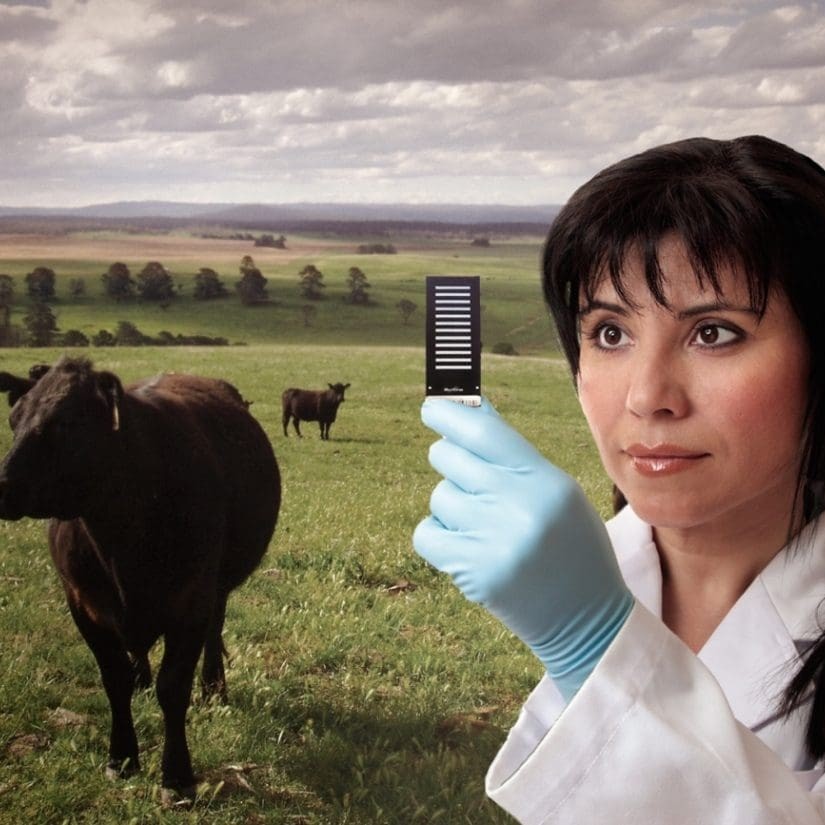 The Beef CRC expects to deliver genomic predictions that identify animals genetically superior for carcase and beef quality, feed efficiency and female fertility traits by May next year.
The Beef CRC expects to deliver genomic predictions that identify animals genetically superior for carcase and beef quality, feed efficiency and female fertility traits by May next year.
Beef CRC chief executive Dr Heather Burrow said this is one of the current CRC’s main outcomes and researchers were on track to deliver the prediction tools within six months.
The DNA tests were currently being validated in independent cattle populations, a CRC release issued yesterday said.
“The research undertaken by the Beef CRC and its partners will deliver more detailed DNA information on Australian cattle breeds than has ever been achieved,” Dr Burrow said.
The genomic predictions will allow seedstock cattle breeders to more accurately identify animals that are genetically superior for carcase and beef quality, feed efficiency and female fertility traits such as age-at-puberty, first-calf re-breeding and lifetime reproductive performance in tropically adapted cattle breeds.
The predictions will be incorporated into Breedplan to improve the accuracy of the current Estimated Breeding Values which are based on extensive phenotypic records and pedigree information.
Dr Burrow said the Beef CRC had recently completed genotyping more than 10,000 research animals and 1300 industry sires using the latest DNA ‘super chips.’
The new genomic predictions were developed using Illumina’s new 700K chips and their accuracy will be improved over coming months before being delivered to Breedplan and genomics companies operating in Australia.
Beef CRC chief scientist Professor Mike Goddard said the new 700K chips measured more than 700,000 unique genetic variations (SNPs) within an individual animal’s genome, and across the genomes of multiple animals, to identify the unique genetic attributes linked to the most important production traits.
The Beef CRC has recently completed calibrating the genomic predictions within breeds, based on DNA samples provided from 1300 high-accuracy sires from several breeds.
Dr Burrow said the greatest value for adding genotype information to Breedplan would be for young animals that did not yet have any measurements on them or their progeny or for the very hard or expensive to measure traits that are generally not recorded by industry.
“That is where the greatest potential lies in improving the accuracy of predicting that animal’s performance,” she said.
“Producers will then be able to select for these hard to measure traits in young animals, something they have not been able to do up until now.”
Industry perspective
 Providing an industry perspective to the new test was the general manager of the Charolais Society of Australia, Terry Farrell.
Providing an industry perspective to the new test was the general manager of the Charolais Society of Australia, Terry Farrell.
He said providing sire samples for the CRC’s industry sire genotyping project which helped calibrate the new genomic predictions within breeds, meant Charolais breeders would be able to closely map genotypes back to EBVs for traits such as tenderness, meat flavour, fat type and fat colour.
“Currently, the predictions for some of those meat quality traits were not as accurate as we would like. The CRC’s genotyping project has also worked-in well with our other Beef Information Nucleus research projects, where we are collecting birth, growth and meat quality data on sires and their progeny. This data will greatly enhance our predictions for these traits,” he said.
“Many breeders are wondering where genomics research is heading because the technology is advancing all the time. I find a lot of people are still struggling with the concept of what an EBV is, let alone a genomic EBV.”
“But all they need to know is that genomics will be integrated into Breedplan to produce a more accurate EBV,” Mr Farrell said.
“It’s critical for the Charolais breed to be part of this research and we believe the genotypes for each of the breeds should be made available to cattle researchers. If we can confidently identify the best animals within Charolais and across other breeds, we will be able to make greater genetic progress than we have done in the past.”
“The Beef CRC research will also provide tools to access the large Charolais datasets held overseas, so we can start predicting traits by family lines. This will save a lot of money in the future and will allow us to better meet the requirements of our domestic and international beef markets.”
How the new breeding predictions will work:
Here’s a typical scenario illustrating how the new breeding predictions will work.
A cattle breeder has a young weaner that has not yet been scanned for any ultrasound data. The breeder wants to predict the weaner’s genetic merit for high marbling or beef tenderness, to know whether to put the animal into a breeding program.
The breeder takes a hair sample from the animal and sends it to his breed society or directly to a genotyping laboratory. The laboratory genotypes the animal and sends the results to Breedplan, where the genotypes are combined with other information such as pedigree and recorded measurements on the animal and its relatives.
Using a calibrated mathematical formula, a genomic prediction is made on the animal’s genetic merit for all the Breedplan traits.
The breeder will receive EBVs in exactly the same way as currently occurs, except the EBVs will have an improved accuracy due to the inclusion of the additional validated genomic information.
